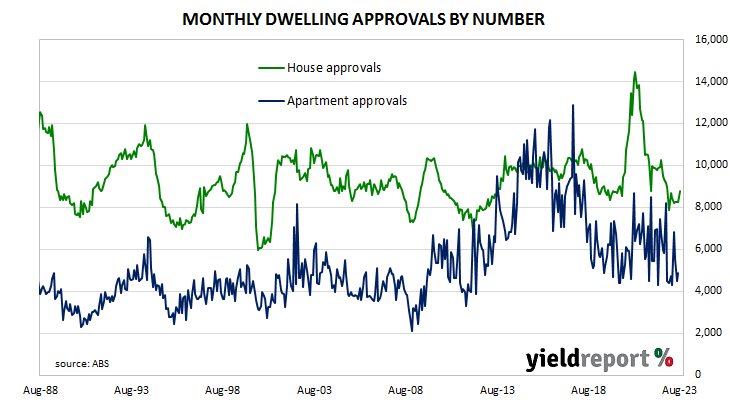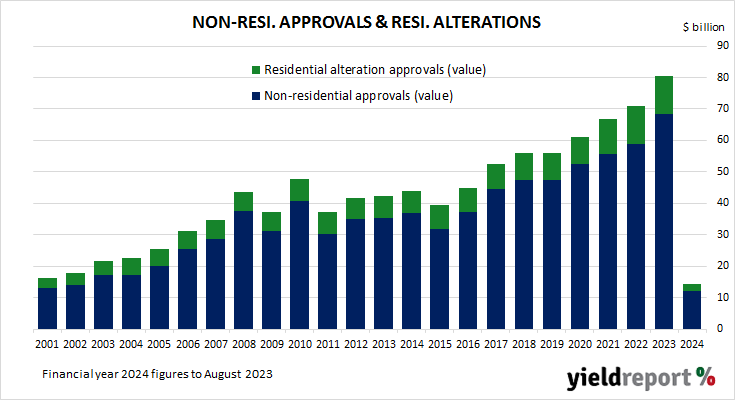Home approval numbers up 7.0% in August, above expectations; 22.9% lower than August 2022; Westpac: underlying picture a gradual up-trend from weak level; Westpac: prospects for dwelling approvals still look mixed at best; house approvals up 6.0%, apartments up 8.8%; non-residential approvals up 1.5% in dollar terms, residential alterations down 2.4%.
Building approvals for dwellings, that is apartments and houses, headed south after mid-2018. As an indicator of investor confidence, falling approvals had presented a worrying signal, not just for the building sector but for the overall economy. However, approval figures from late-2019 and the early months of 2020 painted a picture of a recovery taking place, even as late as April of that year. Subsequent months’ figures then trended sharply upwards before falling back through 2021, 2022 and the first half of 2023.
The Australian Bureau of Statistics has released the latest figures from August which show total residential approvals rose by 7.0% on a seasonally-adjusted basis. The result was a greater one than the 2.5% gain which had been generally expected and in contrast with July’s 7.0% fall after revisions. However, total approvals still fell by 22.9% on an annual basis, down from the previous month’s revised figure of -10.3%. Monthly growth rates are often volatile.
“The result comes off two months of sizeable declines led by units,” said Westpac senior economist Matthew Hassan. “Despite the positive result, the underlying picture still looks to be of a gradual up-trend from a weak level with the unit gains unlikely to be sustained.”
Long-term Commonwealth Government bond yields rose moderately on the day, somewhat lagging overnight movements of US Treasury yields. By the close of business, the 3-year ACGB yield had crept up 1bp to 4.10% while 10-year and 20-year yields both finished 5bps higher at 4.56% and 4.87% respectively.
In the cash futures market, expectations regarding further rate rises softened slightly. At the end of the day, contracts implied the cash rate would increase from the current rate of 4.07% and average 4.125% through November, 4.195% in December and 4.275% in February. May 2024 contracts implied a 4.31% average cash rate while August 2024 contracts implied 4.30%, 23bps more than the current rate.
“Stepping back from the latest monthly data, prospects for dwelling approvals still look mixed at best,” Hassan added. “On the positive side, population-driven demand is clearly strong and wider housing markets are seeing a recovery. However, there still look to be significant legacy problems from the surge in construction costs, which has still to run its course, and capacity issues with a major wave of building sector insolvencies and labour shortages.”
Approvals for new houses rose by 6.0% over the month, up from July’s 0.3% gain after revisions. However, on a 12-month basis, house approvals were still 14.5% lower than they were in August 2022, up from July’s comparable figure of -16.7%.
Apartment approval figures are usually a lot more volatile and August’s total rose by 8.8% after a 18.9% drop in July. The 12-month growth rate fell from July’s revised rate of 4.4% to -34.5%.
Non-residential approvals decreased by 1.5% in dollar terms over the month but were 25.5% higher on an annual basis. Figures in this segment also tend to be rather volatile.
Residential alteration approvals declined by 2.4% in dollar terms over the month and were 1.5% lower than in August 2022.



